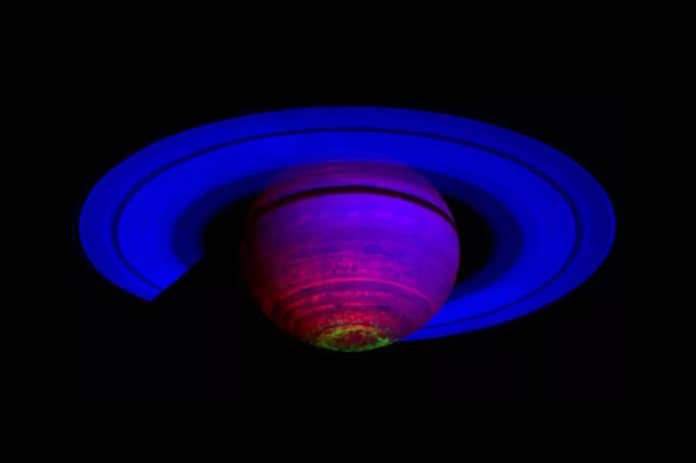Like Earth, auroras also happen to other planets. At Saturn, it’s all very different. As the planet’s atmosphere is dominated by hydrogen, Saturn’s auroral displays can only be seen in ultraviolet light.
Surprisingly, many questions revolving around Saturn’s Ultraviolet Auroras remain unanswered, even after the outstanding success of the Cassini mission.
A new study based on observations made with the W. M. Keck Observatory on Maunakea has unraveled a never-before-seen mechanism fueling aurora on Saturn. The team led by the University of Leicester has found that Saturn is unique among planets observed to date in that some of its aurorae are generated by swirling winds within its atmosphere and not just from the planet’s surrounding magnetosphere.
Auoroas on other planets are only formed by powerful currents that flow into the planet’s atmosphere from the surrounding magnetosphere. These are driven by either interaction with charged particles from the Sun (as at the Earth) or volcanic material from a moon orbiting the planet (as at Jupiter and Saturn).
Ph.D. researcher Nahid Chowdhury, a member of the Planetary Science Group within the University of Leicester’s School of Physics and Astronomy, said, “Saturn’s internal rotation rate has to be constant, but for decades researchers have shown that numerous periodic properties related to the planet – the very measurements we’ve used at other planets to understand the internal rotation rate, such as the radio emission – tend to change with time.”
“What’s more, there are also independent periodic features seen in the northern and southern hemispheres which themselves vary throughout a season on the planet.”
“Our understanding of the physics of planetary interiors tells us the true rotation rate of the planet can’t change this quickly, so something unique and strange must be happening at Saturn. Several theories have been touted since the advent of the NASA Cassini mission trying to explain the mechanisms behind these observed periodicities.”
“This study represents the first detection of the fundamental driver, situated in the upper atmosphere of the planet, which goes on to generate both the observed planetary periodicities and aurorae. It’s thrilling to provide an answer to one of the longest-standing questions in our field. This is likely to initiate some rethinking about how local atmospheric weather effects on a planet impact the creation of aurorae, not just in our solar system but farther afield too.”
Scientists used Keck Observatory’s Near-Infrared Spectrograph (NIRSPEC) to measure infrared emission from Saturn’s upper atmosphere. They then mapped the varying flows of Saturn’s ionosphere throughout a month in 2017.
Tom Stallard, Associate Professor in Planetary Astronomy at the University of Leicester and co-author of the study, said, “This was one of the best observing experiences I’ve ever had. It was a joy to be able to spend so much time at Keck, taking a couple of hours of data at the start of the night, once every four to five nights, during my five-week stay in Hawaiʻi. The opportunity to work with Keck’s team enabled us to capture one of the most exquisite datasets we’ve ever produced!”
Scientists then fixed the map against the known pulse of Saturn’s radio aurorae. This showed that a large proportion of the planet’s aurorae are generated by the swirling pattern of weather in its atmosphere. They are responsible for the planet’s observed variable rate of rotation.
According to scientists, the energy from Saturn’s thermosphere drives this system, with winds in the ionosphere observed between 0.3 and 3.0 kilometers per second.
Stallard said, “The University of Leicester has long been involved in measuring the effects of this discovery – we’ve observed how the pulsing aurorae and the wobbling magnetic field lines stretching out into space highlight a changing rotation rate. For two decades, our researchers, along with the wider scientific community, have speculated about what might be driving these strange periodicities. Over the years, scientific meetings have had late-night discussions about whether the volcanic moon Enceladus might be the cause, interactions with the thick atmosphere of the moon Titan, or perhaps interactions with Saturn’s bright rings. But recently, many researchers have focused on the possibility that it is Saturn’s upper atmosphere that causes this variability.”
“This search for a new type of aurora harks back to some of the earliest theories about Earth’s aurora. We now know that aurorae on Earth are powered by interactions with the stream of charged particles driven from the Sun. But I love that the name Aurora Borealis originates from the ‘the Dawn of the Northern Wind.’ These observations have revealed that Saturn has a true Aurora Borealis – the first-ever aurora driven by the winds in the atmosphere of a planet.”
Kevin Baines, a JPL-Caltech-based co-author of the study and a member of the Cassini Science Team, said, “Our study, by conclusively determining the origin of the mysterious variability in radio pulses, eliminates much of the confusion into Saturn’s bulk rotation rate and the length of the day on Saturn.”
Journal Reference:
- Chowdhury, M. N., Stallard, T. S., Baines, K. H., Provan, G., Melin, H., Hunt, G. J., Moore, L., Thomas, E. M., Wang, R., Miller, S., & Badman, S. V. (2022). Saturn’s Weather-Driven Aurorae Modulate Oscillations in the Magnetic Field and Radio Emissions. Geophysical Research Letters, 49(3), e2021GL096492. DOI: 10.1029/2021GL096492
